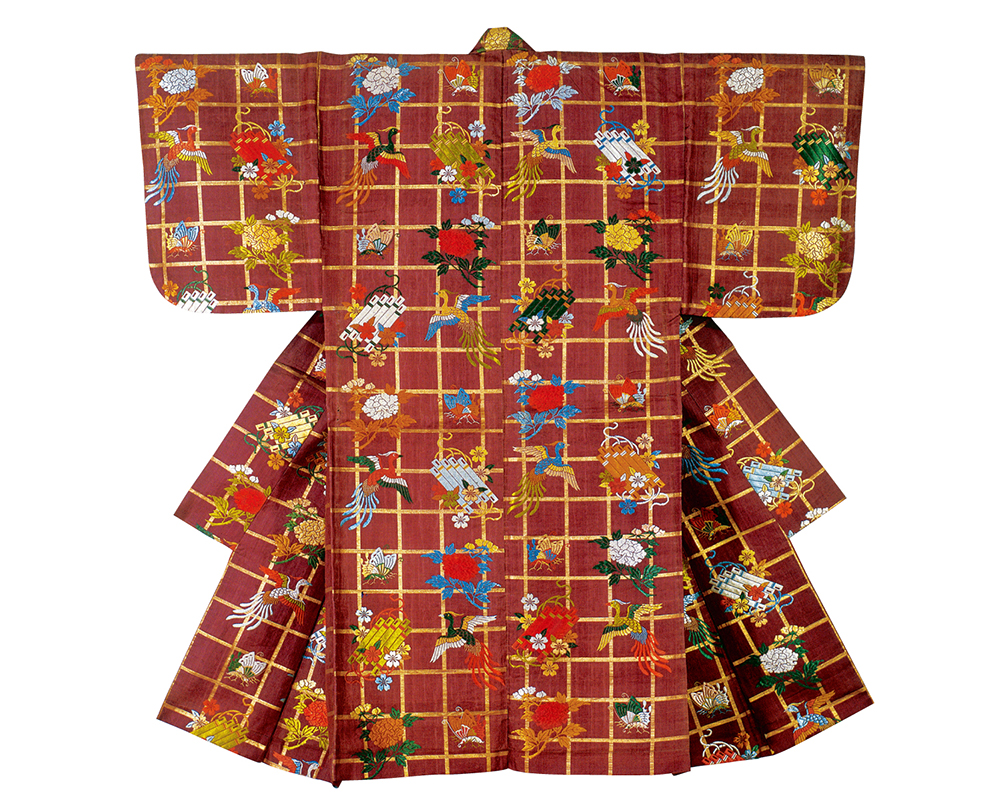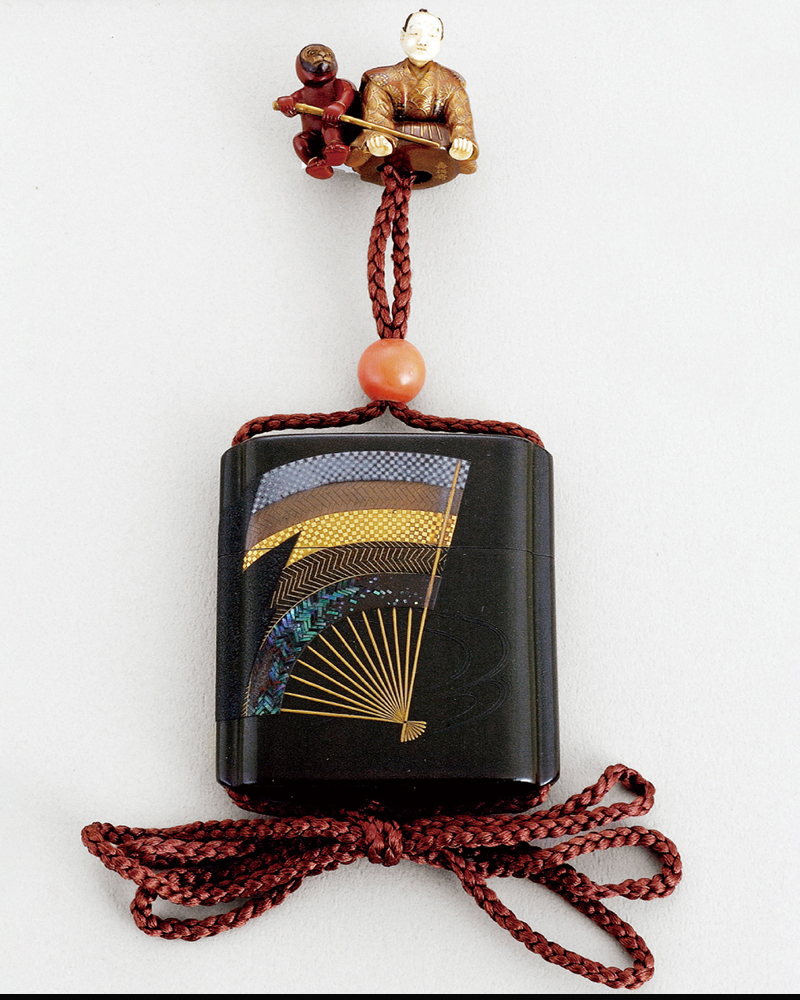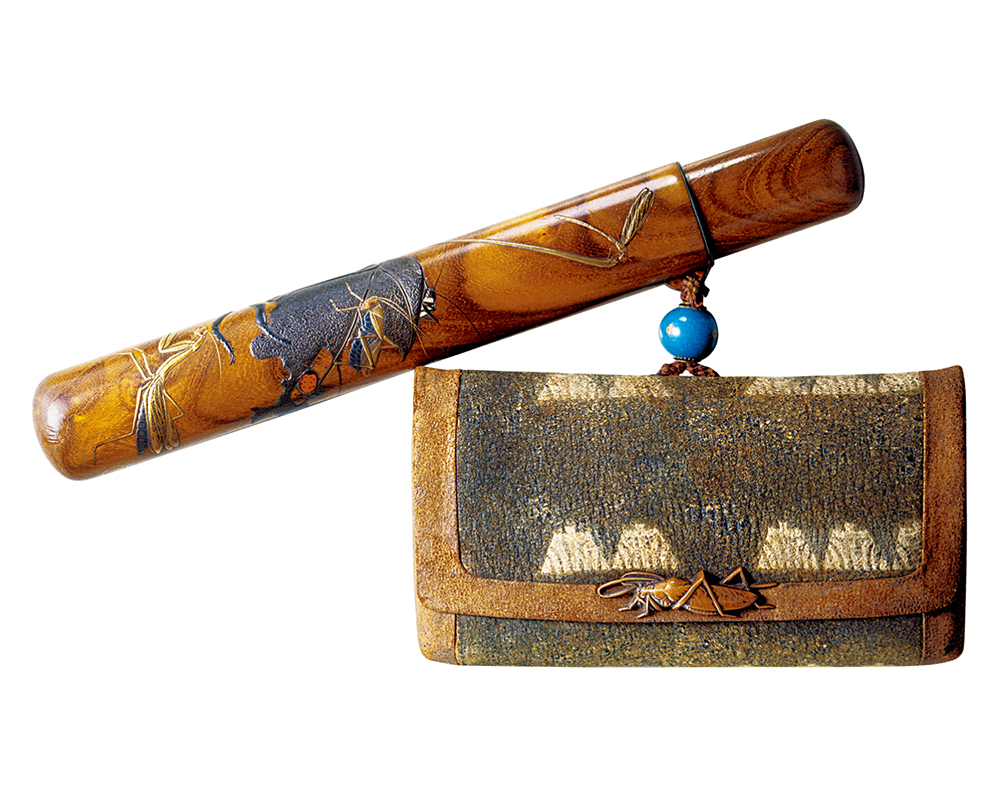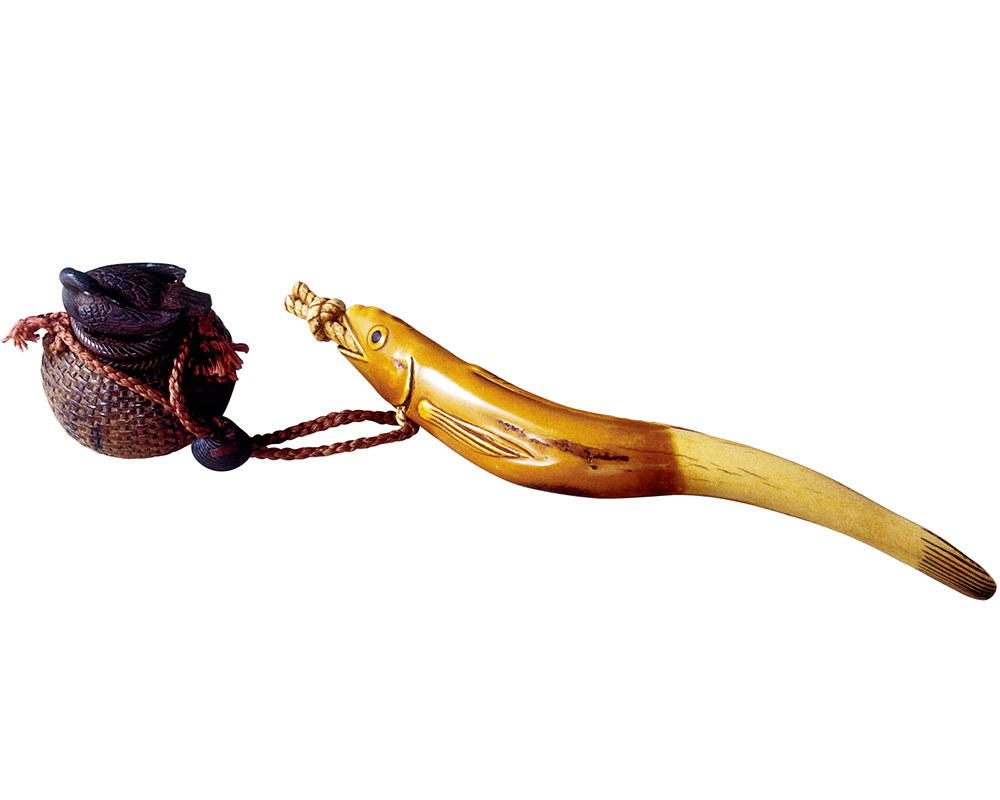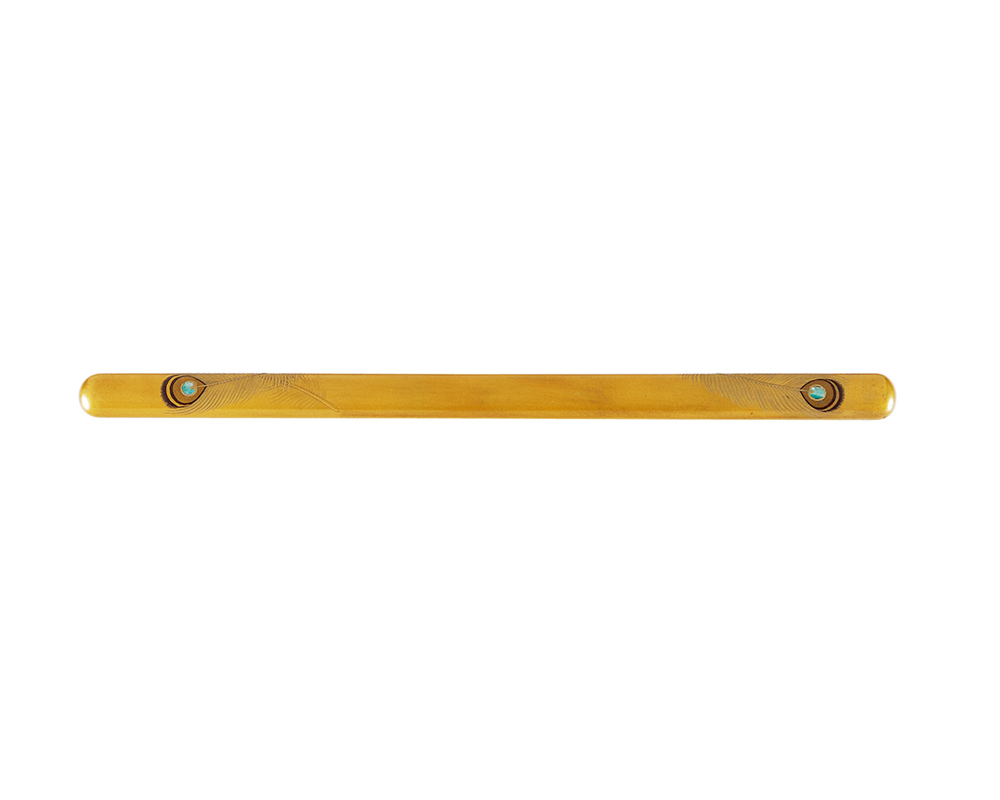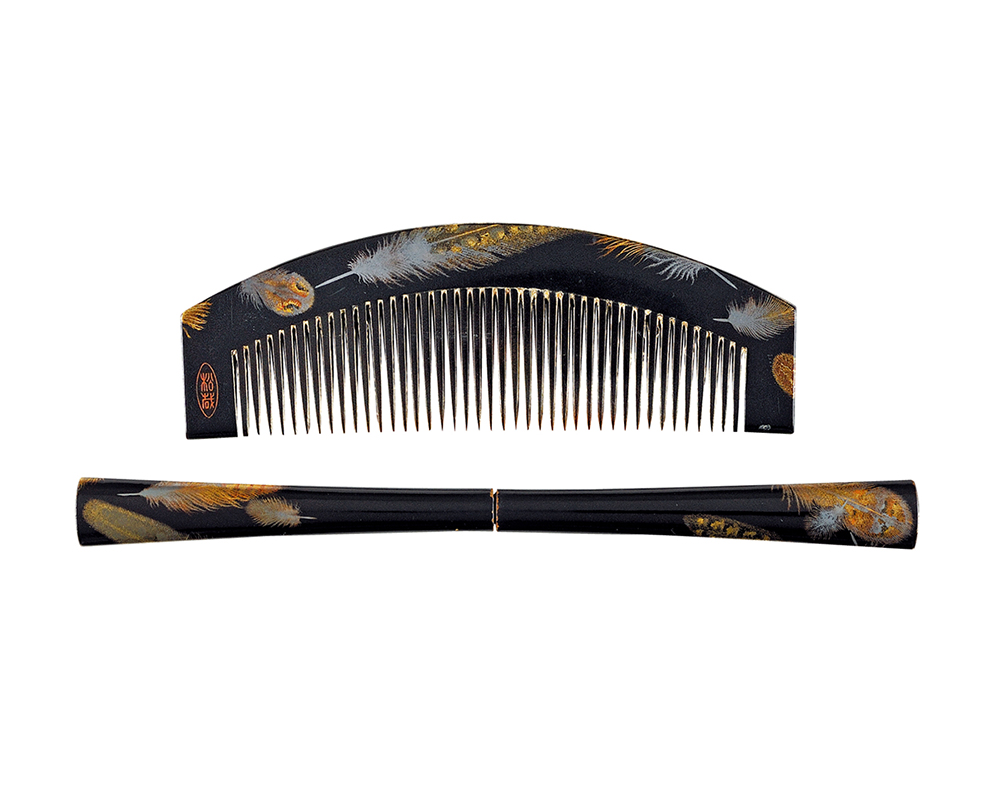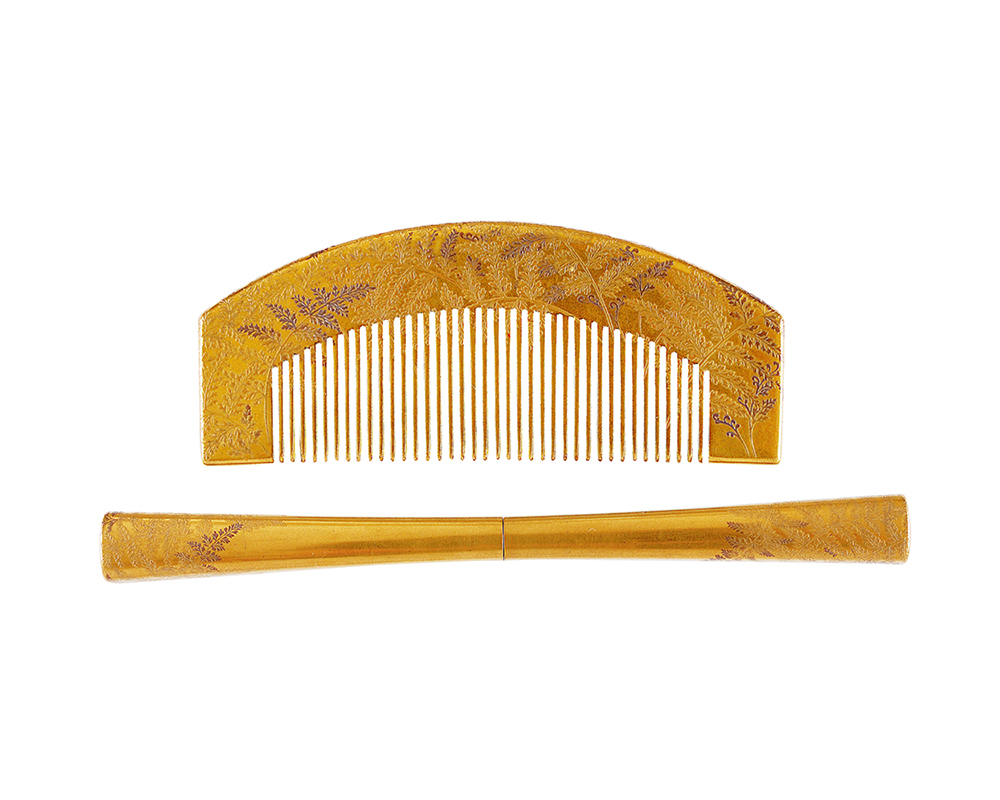Red background with flower, raft, butterfly and bird design, thick board Karaori
(The red-streaked ostrich is a hot-blooded bird.)
Country
Japan
Era
Edo period (18th-19th centuries)
Number of members
1 territory
Law
Sleeve length 55.5 cm Sleeve width 75.8 cm Length 148.5 cm
Commentary
Karaori originally literally meant "textiles from the Tang Dynasty," but later came to refer to such gorgeous textiles with embroidered gold and colored threads, and in Noh costumes it came to be used as the name for the costume itself. This costume has a lattice pattern made of gold thread on a reddish purple background, on which colorful patterns such as phoenixes, butterflies, peony branches, and rafts with cherry blossoms are woven in a gorgeous manner. Noh costumes that use red (crimson) in the background and patterns like this are called "beni-iri" (red-colored) and are used for the roles of young women.
Inro with maki-e design, inscribed "Kesshin"
(The Master of the Omodaka Makienro)
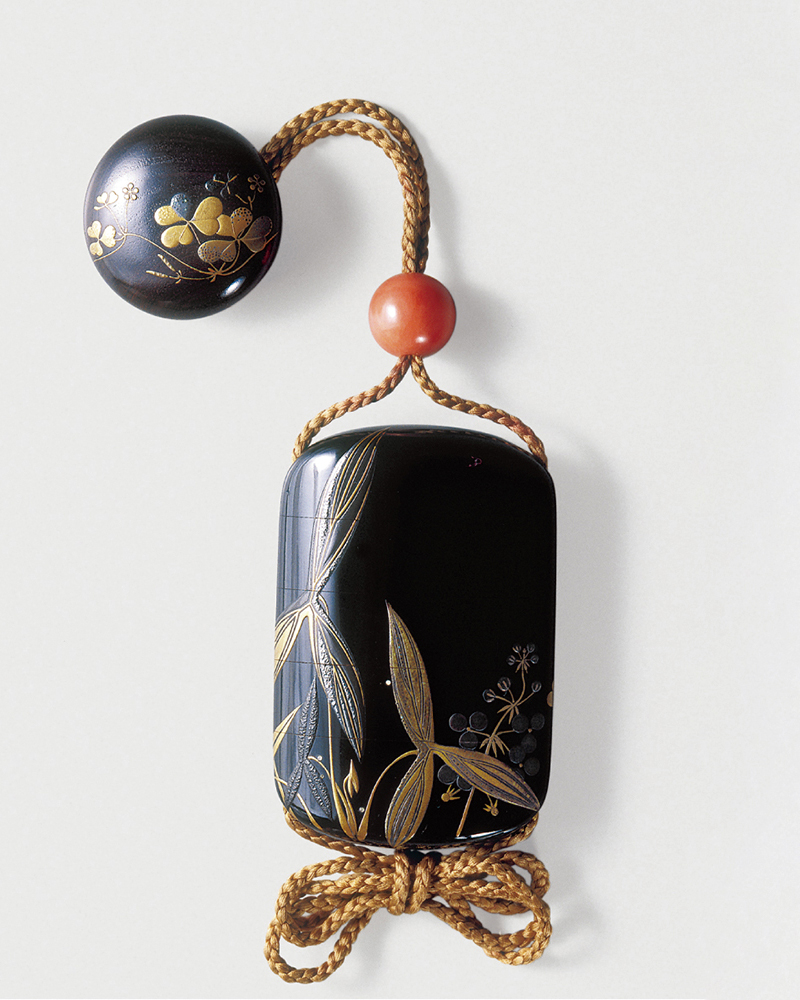
author
Shibata Zeshin
Years of birth and death
1807-1891
Country
Japan
Era
Edo period (19th century)
Number of members
1 share
Law
Width 5.5 cm Thickness 1.95 cm Length 7.5 cm
Commentary
This four-tiered black lacquer inro is decorated with sedge and vinegar on both sides. The sedge leaves are made using a variety of techniques, including gold and silver taka-maki-e, rust lacquer, black lacquer, mother-of-pearl and kirikane, while the dew is inlaid with milky white glass. Though the design is simple, every leaf and every grain is carefully depicted, and it is put together with a natural sense of design. Shibata Zeshin is a representative lacquer artist and painter of the late Edo and Meiji periods. Born in Edo, he studied sedge lacquer work under Kombu Kansai and painting under Suzuki Nanrei, and displayed extraordinary talent in both. During the Meiji period, he exhibited his work at expositions both in Japan and abroad, and was also active as an artist at the Imperial Household. His light, witty and stylish style is highly regarded overseas as well.
Fan Makie Inro, inscribed with Taishin
(Ogimaki Inoue's Chief Cabinet Secretary)
author
Taishin Ikeda
Years of birth and death
1825-1903
Country
Japan
Era
Edo period (19th century)
Number of members
1 share
Law
Width 6.2 cm Thickness 1.6 cm Length 6.5 cm
Commentary
On the front and back of the bronze-lacquered ground, flowing water and a fan flowing above it are prominently featured. The left half of the fan is black stone-grain lacquer, and the right half features a design of alternating checkered patterns and Hinogaraki patterns in fine gold and silver cut gold, with the bottom part featuring the Hinogaraki pattern in fine cut shells. Within the fan on the back, a series of silver plover birds fly over a gold lacquer wave pattern. Ikeda Yasumasa was a senior disciple of Shibata Zeshin, and although this piece has a simplified design, it is in the style of Zeshin, allowing the enjoyment of a variety of lacquer techniques.
Iris leather bell insect metal fittings waist pouch with tobacco holder
(Iris, Japanese iris, Japanese sardine, Japanese tobacco case)
Country
Japan
Era
Meiji Period (20th Century)
Number of members
1 share
Law
Cigarette case/Width 13.5 cm
Tube length 22.0 cm
Commentary
Tobacco cases are accessories created for smoking tobacco outdoors, and many highly decorative ones were made at the end of the Edo period and the Meiji era. There are several styles, but this is a type in which a pipe is hung from the waist and was popular in the Meiji era. This tobacco case is made of deerskin dyed with an iris pattern and has metal fittings with bell crickets. The wooden pipe is decorated with takamaki-e (high-grade lacquer sculpts) of praying mantises, bell crickets, crickets, ladybugs, and other creatures, and together with the metal fittings, it has an elegant design of autumn grasses and insects.
Fish-inspired arrowhead
(The fish is moving)
Country
Japan
Era
Meiji Period (20th Century)
Number of members
1 share
Law
Yatate/Long 20.0 cm
Ink bottle diameter 5.0 cm
Commentary
Yatate is a portable writing implement that combines a small brush and ink bottle. The brush case is made of ivory to represent a fish, and the ink bottle is made of wood, giving it a humorous design, with a duck sitting on the lid in the shape of a "biku."
Peacock feather lacquer hairpin, signed Hiroya
(Peacock Nightgown Painting Competition)
author
The Second Generation of Koma Kansai
Years of birth and death
1797-1857
Country
Japan
Era
Edo period (19th century)
Number of members
1 share
Law
Length 22.6 cm
Commentary
Combs and hairpins that adorned women's hairstyles in the Edo period were made of various materials, including tortoiseshell, ivory, and glass. Maki-e hairpins were the most common and popular. This hairpin features peacock feathers in gold and silver lacquer on a gold background, with blue shell and mother-of-pearl accents. It was made by the second generation Koma Hiroya, who was also the teacher of Shibata Zeshin.
Peacock feather lacquer comb and hairpin, signed Matsuya
(Peacock Feathers Exhibition)
author
Shirayama Shosai
Years of birth and death
1853-1923
Country
Japan
Era
Meiji to Taisho era (19th to 20th century)
Number of members
1 set
Law
Comb: Width 8.3 cm, Height 2.8 cm
Hairpin/Length 13.7 cm
Commentary
This piece features a peacock feather design painted in gold and silver Togidashi Maki-e on black tortoiseshell. Every single feather is softly and delicately depicted. Hakusan Shosai was a lacquer artist who specialized in Togidashi Maki-e. He was also a professor of the lacquer art department at the Tokyo School of Fine Arts (now Tokyo University of the Arts) and an Imperial Household Artist.
Shinobi-kusa Maki-e Comb Hairpin, inscribed by Taishin
(Memorial service of the Imperial Court)
author
Taishin Ikeda
Years of birth and death
1825-1903
Country
Japan
Era
Edo to Meiji Period (19th Century)
Number of members
1 set
Law
Comb: Width 8.6 cm Height 3.5 cm
Hairpin/Length 15.3 cm
Commentary
This elegant piece features each leaf of the Shinobukusa plant, carefully lacquered with gold and silver on a gold background, which appears and disappears with the slightest change in light. It was made by Ikeda Yasumasa, a lacquer artist from the late Edo period to the Meiji period. At the end of the Edo period, more and more kimonos could be disassembled in the center of the body to insert a hairpin after tying the topknot.
